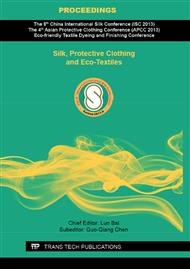p.57
p.62
p.67
p.72
p.79
p.83
p.87
p.92
p.98
Observations of Skin Tissue Regenerations in Biomaterial Scaffolds with Different Biodegradability
Abstract:
Objective: To explore the effects of the biodegradability of biomaterial scaffolds on skin tissue regeneration and its neovascularization by the animal experiments. Methods: A piece of porous silk fibroin film (SF) of easy biodegradation and a piece of porous polyvinyl alcohol film (PVA) of hard biodegradation were implanted into a same skin wound of adult rat, and the differences in the regenerative blood vessel and tissue at 5, 10, 16, 41 days after surgery were observed by histological methods. Results: (1) at 10 days after surgery, the SF started to degrade, the closed areas without cell infiltration were opened up and the entire material was filled with the regenerative tissue, and there were still the closed areas in the PVA, (2) the new vascular network remodeling in the SF and PVA appeared at 10 days and 41 days after surgery, respectively, and (3) at 16 days after surgery, most of the SF material had degraded and substantially been replaced with the regenerative tissue, and the visible degradation of the PVA appeared at 41 days after surgery. Conclusion: The good biodegradability of the SF was helpful both to all vascularization of the material and to the regenerative blood vessels remodeling, and the regenerative tissue was closer to the normal dermal tissue than in the PVA.
Info:
Periodical:
Pages:
79-82
Citation:
Online since:
September 2013
Authors:
Price:
Сopyright:
© 2013 Trans Tech Publications Ltd. All Rights Reserved
Share:
Citation:


